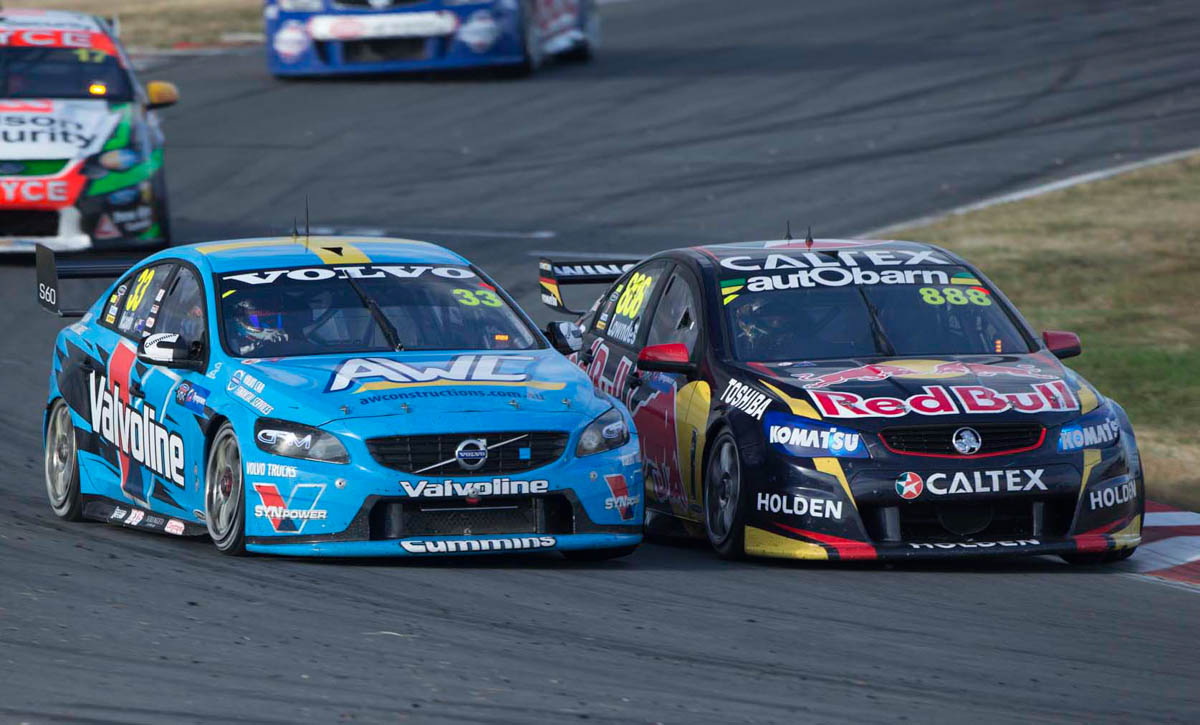V8 Supercars to permit turbo engines for 2017
 |
| Current V8 cars |
– V8 Supercars to maintain high-octane, dynamic racing platform – fast, loud and aggressive
– Gen2 Supercar opens the sport to new engine and body configurations, alongside V8 engines
– Increased relevance to manufacturers, race fans, teams and sponsors
– DNA remains front engine, rear wheel drive, four seat configuration
– V8 Supercars reveals refreshed master brand as the sports' identity from 2015
V8 Supercars has set out the next phase of growth for the sport, with the release of details contained in the 2017 White Paper. This next phase is designed to allow for the possibility of a greater range of brands and models from 2017.
The first phase opened the garage to the cars we see today. Five manufacturers now feature on the grid – Erebus Motorsport with their customer AMG E63 program, Ford, Holden, Nissan and Volvo – with all makes tasting success with race victories, pole positions and podiums.
The Gen2 Supercar is the next stage for the sport following the implementation of the new generation V8 Supercar in 2013 which allowed new manufacturers to compete, setting the sport up for ongoing success and growth.
The V8 Supercars' Board unanimously approved the blueprint, to be introduced at the start of the 2017 season, which opens the way for additional engine and body configurations to compete alongside current V8 engines and four door sedans.
The 2017 blueprint means the current V8 Supercars could be joined by turbo-charged six or four cylinder engines from 2017.
The Gen2 Supercar model is designed to be more relevant to more manufacturers, race teams, sponsors and fans while continuing V8 Supercars' promise of providing fans with the ultimate in high octane entertainment.
The top-line guidelines dictate that the car must be publicly available for sale in Australia, is front engine, right hand drive and a full four-seat configuration. The race car must be rear wheel drive and accurately reflect the look of the road car, retaining the essential DNA of the sport. All cars will use the existing Car of the Future chassis and control components, and be subject to engine and aero parity rules.
In 12 months of planning, V8 Supercars consulted with the major manufacturers, participating and otherwise, race teams, sponsors, stakeholders and fans in the process of developing the 2017 direction.
Research clearly showed that while core support for the sport is strong, opening to other brands and engines would have substantial appeal, particularly to younger fans.
"It is imperative to keep the sport relevant to the current environment, entertaining and, critically, viable for the race teams," V8 Supercars CEO James Warburton said.
"The current climate in world motorsport is absolutely clear. Manufacturers want choice in what they go racing with, otherwise they won't participate. They want their DNA represented and so do we. We will not compromise our DNA – fast, loud and fierce racing."
The cars will continue to be loud and high powered, irrespective of their engine configuration. The competitiveness and dynamic racing the sport is renowned for will not be compromised.
"The sheer brute power and sound of V8 Supercars is synonymous with the sport," Warburton said. "A key area will be retaining the acoustic effect of high powered race cars no matter the engine or make."
In the next 12 months two working groups – one focusing on engine configuration and the other body configuration – will draft technical specifications and rules to ensure parity across the field, and in turn the highly competitive racing the sport enjoys. The rules will ensure no engine or body configuration has any advantage or disadvantage over another.
The groups will be headed by V8 Supercars' motorsport department which will be tasked with making recommendations to the V8 Supercars Commission which includes representatives of V8 Supercars, race teams and independents. These groups will consult with participating manufacturers and teams throughout the process.
The technical groups will aim to publish draft engine and body style operating guidelines for discussion by mid-2015. These guidelines will be defined towards the end of 2015, allowing testing to commence from February 2016.
The 2017 blueprint also contains a new master brand for the sport to coincide with the media rights agreement with Fox Sports, Ten, Foxtel and News Limited from next year.
It is a simpler, more contemporary, tier-one brand identity more consistent with elite sporting properties and will be integrated into all areas of the sport during 2015.
